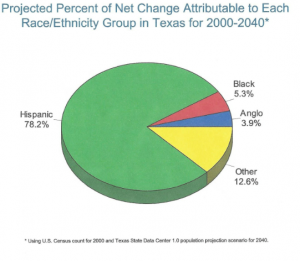From the Sunday Chron op-ed pages:
Texas is headed for the ditch, but few people are aware of the state’s perilous path. The demographers have seen the future, though, because it’s foretold in their numbers. And they’ve been sounding the alarm.
There hasn’t been much of a public-policy response, so far.
Texas could be the pacesetter: It has a young and rapidly growing population. Educate that workforce and Texas becomes a vibrant, thriving state for decades. Unfortunately, that young population is overwhelmingly minority and under-educated, and there appears to be little political interest in addressing the needs of that demographic group.
Increasingly, Texas stands to become poorer and less competitive, according to demographers who study the numbers for a living. Neither state leaders nor the media is paying adequate attention. Few Texans are aware of the state’s rapidly changing population. Hispanics will surpass whites as the largest population group some time before 2020.
By the numbers, here’s what’s been taking place: The state lost 184,486 white children between 2000 and 2010 while gaining 931,012 Hispanic children over that decade, according to the U.S. Census. Stated another way, in 2000, Texas white kids outnumbered Hispanic children by 120,382; Flash forward to 2010 and Hispanic children outnumbered white kids by 995,116.
This gap will continue to widen. Demographer Steve Murdock notes the average white female is 42 years old compared to an average age of 28 for Latinas. And the fertility rate is 1.9 children for the white female compared to 2.7 for the Latina. Demographers say replacement of a population group requires a fertility rate of at least 2.1.
Whites are projected to make up fewer than 4 percent of the state’s population growth between now and 2040, compared to 78 percent for Texas Hispanics.
Here’s the most important figure: All of our K-12 enrollment growth over the past decade comes from low-income children – that is, children whose family income qualifies them for free and reduced-cost school lunches. Those low-income students now make up a little more than 60 percent of our public school enrollment.
Many are way behind when they arrive in the first grade. Too many drop out years later. A whopping 47 percent of low-income high school students from the Class of 2015 were off track to graduate, according to testimony in last year’s public school finance trial.
Why does this matter? Murdock, who served as director of the U.S Census Bureau in the administration of President George W. Bush, projects that three out of 10 Texas workers will not have a high school diploma by 2040. Also, in 25 years, the average Texas household income will be some $6,500 less than it was in the year 2000. The figure is not inflation-adjusted, so it will be worse than it sounds. Basically, today’s children, collectively, stand to be worse off than preceding generations.
How can we address the trend line? The first step is to increase access to high-quality pre-K, Murdock says.
[…]
The demographers are warning us about the not so-rosy future if we fail to act. Education is the answer. Education is the best ticket out of poverty. We simply need state leaders to understand a universal truth: It doesn’t cost to educate a child; it pays to educate a child.
This is a condensed version of a longer piece by former Chron and Express-News reporter Gary Scharrer, which first appeared on Texas To The World. Scharrer was more recently on the staff of now-former Sen. Tommy Williams. Steve Murdock is a familiar name in this blog – he’s been singing this tune for well over a decade now, not that the powers that be have been listening. Here’s an interview I did with him in 2011, just as the Legislature was getting set to cut $5.4 billion from public education and $200 million from pre-k, because they suck like that. As we know, these issues are salient in the election for Governor this fall. You tell me whose pre-k plan, not to mention whose overall vision for education, is a better fit for our future.

